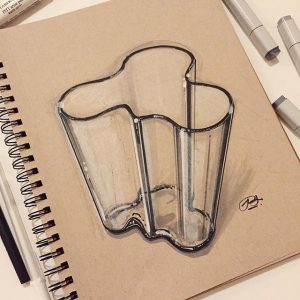The Aalto Vase, also known as the Savoy Vase, is a piece of glassware created by Alvar Aalto and his wife Aino that has become an internationally known iconic piece of Finnish design. It became known as the Savoy Vase because it was one of a range of custom furnishings and fixtures created by Alvar and Aino Aalto for the luxury Savoy restaurant in Helsinki that opened in 1937.

The reason why I want to present this artistic product is that itself is a media that broadcast its background culture and manufacturing process all over the world through a long period of time till now. “Savoy” bottle is the symbolic image of Finland, if you put a “Savoy” bottle on the table, indicating that you not only like the design, and like the Finnish design, like Aalto design. Few people use it do not know who designed the bottle. Indeed, a bottle designed a national symbol, a symbol of the nation.
Another important reason is that “Savoy” bottle represents the national culture of Finland. Also, it represents the culture of global. Such as what Ludwig Mies van der Rohe said before “less is more”- referring to his later efforts to reduce and distal buildings and their components into simple forms in which art and technics – geometry and matter – were integrated in a more persuasive tectonic expression than Behrens, his former master, had ever achieved. As a result, “Savoy” bottle is a simplest bottle but it always the most complicated bottle.
This is the manufacturing process of this bottle
You can see an old and classic edition at British museum:
Add yours Comments – 2
This is an intriguing example, Kimi. I am curious to know more–what does this iconic and highly commercial design object do to advance our discussion of art as a critical term? What about the mass mediated representations of its design process? I would really like to hear you talk more about this in relation to design and architecture.
In reply to Kate,
Thanks for your suggestions. As for the design perspective, this vase reflects a classic design philosophy “less is more”. Actually, people seldom see a product that can be used last for more than 10 years, there are many reasons like the development of the technologies, the qualities of the products, and user experiences of the products, etc. so, we may ask what is a good product? What is the design strategy of the design? Indeed, “less is more” is actually a good answer. the meaning of this phrase is that the simplest design is the best design, “less” is not just means the shape of the products, but also relate to the manufacturing process, material application, and surface treatment process, etc. of the product. In addition, the products have artistic property to engage with the different environment over time. for instance, we can see Aalto Vase deploy in malls, homes, and display space, etc. when it comes to the manufacturing process, factory using the ancient manufacturing technology till now. the process itself is actually an art that constantly the same as before, but we can also say the process of making is always changing in the ontology perspective. We can also see the machine is still the machine, the worker is still the worker, but each vase it manufactured is not the same vase because everything is always changing in every respect. As a result, I have my question, what is the difference between the vase that manufactured now and 50 or 60 years ago? How can we see it through the artistic prospect? Maybe we can use photos, paintings, products, etc. to deployment an art exhibition about Aalto vase to inquire the possibility.